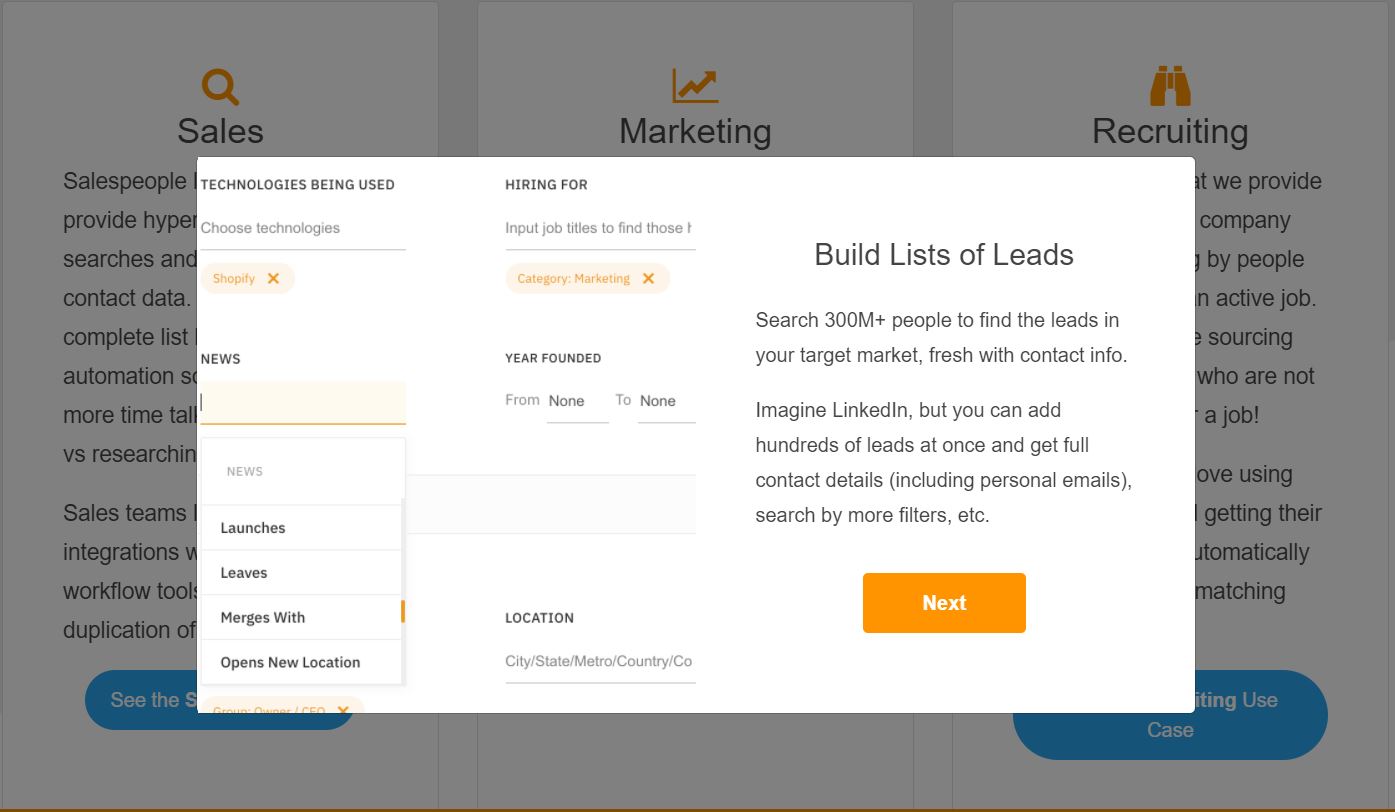
What Is Sales Targeting?
Sales targeting is the act of identifying the prospects more likely to purchase your items and then organizing an appeal specifically to them.
It entails excluding those who are unlikely to purchase your goods and focusing exclusively on those who are critical to your business.
Consider sales targeting as shooting a target with a bow and arrow rather than a shotgun. The “shotgun” technique is reminiscent of earlier sales and marketing efforts when professionals sought to increase sales by contacting as many people as possible. They marketed to hundreds, if not millions, of individuals simultaneously, with no consideration for their demographics or likelihood to enjoy the message.
While the bow and arrow appear to be less powerful than the shotgun in this mental experiment, it offers a number of significant advantages. To begin, it is significantly more precise; with the proper aim, you can precisely locate your target. Additionally, it is less likely to create interference from non-targets.
Your sales success is not contingent on your ability to seal the deal. While you may have a fantastic product, an incredible pitch, and counterarguments to every general argument, your chances of success are reliant on a part of your sales strategy that occurs far earlier—the sales targeting stage.
If you are pitching to someone who does not require your product, it makes no difference how articulate you are, how many wide sales questions you ask, or how many sales figures you reference; they will not be willing to buy.
By comparison, if you’re speaking with someone who is desperate for your goods, you’ll have an easier time convincing them to complete the transaction.
Naturally, sales targeting is a complicated subject, one with which many sales strategists deal. We’ll discuss sales targeting is, why it’s critical, and the actions you’ll need to follow to implement a successful sales targeting plan in this article.
Importance Of Sales Targeting
A Straight Route: Sales Target assists the Sales team in developing a clear roadmap and plan for achieving their sales targets. Once the team has established their yearly goals, they may break them down into quarterly, monthly, and everyday targets, analyze their consumers, and prepare for the full year appropriately. This is also true for senior management, which may coordinate and enhance sales through marketing efforts. The financial department can reduce or expand its payment collecting effort and devote sufficient resources to ensure that the teams meet their targets.
Market Dominance: A well-planned Sales Target, together with the efforts of the Salesperson, enables the firm to increase sales and hence market share. Given that sales is a company’s major and perhaps only income source, it is critical that they focus on growing the sales target and motivating their staff to accomplish it in order for the business to survive and develop.
Long-term objectives: A unified Sales Target would establish the company’s product’s long-term growth in order to achieve a competitive advantage. Additionally, it would establish the product’s flow or trend. For instance, if a product’s prediction is continually decreasing, it implies that the objective is decreasing and, eventually, the sales are decreasing.
11 Steps For Creating A Successful Sales Targeting Strategy
1 Set your goals
Knowing the following facts is critical to your sales targeting strategy:
- How much profit do you make on each product sold?
- How many people must you speak with/contact in order to secure a meeting?
- What should be the frequency of meetings you must attend in order to close a sale?
- What is a client’s lifetime value?
To raise your winning sales ratio with each individual you encounter, you’ll need sales training; specifically, instruction on how to follow a solid sales procedure.
The value of a client is critical to understand since it indicates the prospective value of a customer. If they just purchase from you once, gaining them may be costly and ineffective. However, if they continue to purchase from you, it provides you greater flexibility in budgeting your advertising expenditure to attract a client.
Once you have a firm grasp of the aforementioned data, you can set your sales objectives.
Depending on the data and measurements you’ve come up with, the next may be applicable to you.
- Daily sales objective
- Weekly sales objective
- Your monthly revenue goal
- How many quarterly sales
- The number of sales per year/annum required to meet your objectives.
2 Filter targets to identify ideal customers
This is sometimes the most challenging stage; as a team, you’ll need to identify which demographics and personal characteristics are most likely to lead to a sale or to generate the greatest income for your business.
Consider the following:
- Age. What is the average age of your target customer?
- Gender. Which group of people are you more able to order: men or women?
- Location. Where are the locations of your target customers?
- Income. How much revenue is generated by your sales target?
- Status of the family. Is your sales target a married man or woman? Are they parents?
- Occupation. Where is your sales objective located? What is the title of their position?
If you’re beginning from scratch or having second thoughts about a previous sales targeting approach, you may be perplexed about how to select the “proper” people to target. If you’re stuck, consider the following areas:
Existing clients. Consider your present client base and conduct some research using the information you now possess. Which consumers in your existing base produce the majority of your business’s revenue? What characteristics do they share? Which prospects were the most straightforward to close? Keep track of these characteristics and use them in your future sales targeting strategy.
Competitors. If you lack consumer data to analyze or wish to validate your assumptions, consider examining your top rivals. What kind of consumers are firms like yours after? What demographics do your nearest rivals target? You may not desire to replicate these characteristics precisely in your targeting approach; it may be more profitable to service a niche that the competition is not currently addressing. However, your study should assist you in gaining a better understanding of the most relevant goals for your company.
Conducting surveys and archiving data. Additionally, you may gain additional insight into your intended target demographics by conducting additional direct research. For instance, you may do research using data and results from organizations like as gov, or you can conduct surveys of your existing and future consumers.
You may not choose the optimal option on your first attempt; be willing to adjust your goals in the future.
3 Divide your sale targets
Segmenting your targets is a thing that you must consider when you have come up with multiple audience targets, especially if it’s quite broad. By dividing their targets into discrete and multiple subsections, many businesses benefited and even grew. By splitting your targets, you can make different channels of marketing and assign different members of the team to the various subsets.
For instance, you might divide your major target demographic according to the stages of the typical purchasing cycle; a client could be classified as being in the “research” phase, the “consideration” phase, or the “decision” phase. Your strategy to this consumer will change according to the phase in which they are.
To do this it’s better to utilize online tools that can do your job faster. leadFuze is here for you! LeadFuze enables you to create lists and constantly search via auto-pilot for new leads that match your pre-set criteria. 
4 Set a Scoring System for your target prospects
Although lead scoring is an excellent predictor of a prospect’s enthusiasm in your service or product, it does not always indicate that they are a good fit for your business.
A method for prospect rating can assist you in addressing that question. Using a standard grading scale, each prospect is assigned a letter grade depending on how well they fit the ideal client characteristics. For B2B firms, grading factors may include, but are not limited to, job description, sector, business size, experience level, and geography.
The awarded grade reflects your company’s degree of interest in a client. It helps your sales staff to rapidly eliminate poor matches and target prospects with better ratings. The better the grade, the greater the likelihood of a satisfied consumer.
5 Focus on quality over quantity
Inherently, we believe that the more leads you create, all the more sales you will produce. The fact is that a larger list entails a more diluted message and a great deal of time spent seeking out customers with low potential – time that your sales staff sorely need to be given that only about a 1/3 of their day is spent selling.
By narrowing the list to only the highest-quality prospects, you can develop a stronger connection with them and foster lengthier, more customized interactions. With 80 percent of transactions requiring five follow-up contacts, you want your salesperson to narrow their focus and make those five calls ahead of the competition.
6 Create lists for your ideal prospects based on the Scoring System
Once you’ve identified the sorts of individuals or organizations that would purchase what you’re selling, the following step in your sales targeting plan is to create a list of them.
Once you’ve compiled your list, you ought to determine where they socialize.
They could be active on Facebook.
Is it possible that a competent decision-maker is on LinkedIn?
Once you’ve identified where your target clients congregate, you can begin planning the type of campaign that will generate brand recognition and contact them.
7 Make sure to consider variables in your segmentation lists
Consumers in the same sales target group will exhibit significant variations. For instance, one individual who matches your ideal requirements may have been on a small budget and so unable to purchase your goods, whereas another may have a far larger budget.
If you want to be productive, it’s critical to sketch out and define the variables that are likely to affect the success of your plan.
For instance, are there frequent sales obstacles that jeopardize potentially lucrative sales opportunities? What are they, and how may they be detected in their early stages? How much of an influence do they have on your likelihood of succeeding? Are there any counter-arguments?
8 Set up an approach plan
Now is the moment to develop your pre-call strategy.
The subject of “why” has gotten a lot of attention recently. Nevertheless, few books and techniques explain how to discover the “why.” As a consequence, even when we begin with the “why,” we make assumptions.
Your planning must begin with an awareness of where and what the recipient values.
Make a List of Prospective Client Questions:
- Why is it critical for this business segment to have the proper partner or vendor?
- Why have you prioritized this?
- What factors influenced your decision to work with your present vendor or product?
- Why may you contemplate making a transfer in the future?
- Why would you be worried about shifting?
9 Invest in helpful technology
The fast advancement of technology has disrupted a variety of industries, and the retail market is no exception. Nowadays, sales representatives are equipped with a variety of tools and technologies to assist them in executing their sales plans.
Strategic marketing tools include the following:
- CRMs
- Intelligence in sales
- Lead evaluation
- Automated email
- Web-based collaboration
- Automated telephone dialers
- Meeting Scheduler
With the assistance of these technologies, time in data entry, composing follow-up emails, issuing meeting invitations, and qualifying leads is reduced, allowing more time for real selling.
Just so you know, LeadFuze can be of good use by providing social accounts of potential prospects, which enables multi-channel targeting outreach.
The advantages of these innovations are not restricted to increased productivity. It has the potential to significantly enhance the way you identify, engage, and nurture prospects. You now have access to a lot of consumer data in today’s computerized environment, allowing you to get important insights. By using this data, you can design a novel experience for every prospect and engage with them via the platforms that are most relevant to them.
If you’re not currently including any of these technologies into your sales targeting plan, your rivals most certainly are.
10 Set up a Lead Flow for your sales targeting strategy
The next step of the procedure is to establish a lead flow. To ensure the success of your sales targeting approach, you must first attract the proper people. This generally entails developing marketing and advertising tactics that attract the proper people.
The following are some techniques that may be beneficial:
Select the appropriate social media channels. Certain demographics and segmentation of the audience are more inclined to use specific channels. You’re more likely to discover young mothers on Pinterest than older single males. Understanding the demographics of each platform and utilizing the most effective channels may significantly increase your lead flow.
Create the most pertinent subjects (content marketing). If you use content marketing as a tool, you may target consumers more precisely by creating more focused content.
Pay for tailored advertisements. The majority of current advertising systems offer an extensive array of targeting possibilities. If you have the funds, you can pay to target individuals’ demographical characteristics or even their online behavior. For instance, you may be able to target individuals based on the types of websites they have previously visited or the keywords they have searched in the last few months.
Email nurturing is an effective way to nurture leads. If you use email campaigns, your drip email campaign can also be used to nurture leads. This is especially critical if you attract a large number of people who are still in the early stages of the buying cycle but wish to move them forward. Here, relevant, targeted content is your best ally.
Consider adjusting your lead flow using alternative methods. Marketing, advertising, and sales all allow for significant room for creativity and experimentation.
11 Establish an analysis and measuring system and adapt to occurring changes
There’s one final call for action, and it is a regularly occurring one: you must set aside time to assess, evaluate, and adjust to new information.
How successful are you at converting each segment of your target audience? Which lead generation method generates the most revenue? How accurately predicts your success rate and your lead scoring system? How successful are your lead gen strategies in attracting the right kinds of leads?
Each of these areas has room for improvement, but improving requires an awareness of one’s weaknesses. Utilize the sales metrics you collect to assess your overall performance and determine the most effective strategies for achieving success. This is something you must do consistently and indefinitely in order to maintain a path of continuous improvement. It’s one of several critical sales abilities.
Now that you’ve mastered the art of developing and executing a sales targeting strategy, are you curious about the customers and leads with whom you interact on a daily basis? Are you having difficulty meeting your sales goals without knowing why?
Consider implementing analytic tools to gain a better understanding of your strategy. With tools like EmailAnalytics, you can examine metrics such as the number of emails sent and received, the average time it takes for an email to be responded to, and the average length of an email thread to ascertain the efficacy of your sales strategy.
Conclusion
We hope these 11 sales targeting strategies have been helpful, but they are just a snapshot of the many ways you can increase your product or service sales. And don’t forget to tell us if any of them work; we would love feedback from other entrepreneurs like yourself.


